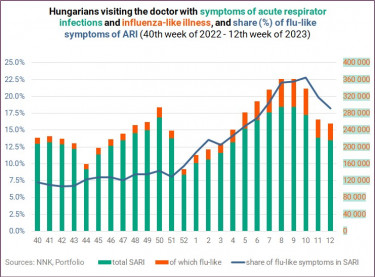Influenza epidemic in retreat in Hungary, but flu dominance grows in samples

The NNK said that on the 12th week of the year, 215,700 people went to the doctor with symptoms of severe acute respiratory infections (down from 221,400 a week earlier), of whom 39,400 (18.3%) were diagnosed with influenza-like illness, in contrast with 44,100 (19.9%) a week earlier.
If it were not for the holiday season when people are less inclined to visit the GP's office and complain about "just a wee cough", we would not see that dip towards end-2022 in the lines below.

The SARI figure shows a 2.6% drop (versus nearly 20% a week ago), and the number of flu-like symptoms has fallen by almost 11% (vs nearly 30% a week ago), but the winding down of the flu season cannot be put into question.
GPs warned three weeks ago that the epidemic could drag out this year and may not be over even at the end of March. while they were hopeful that the milder weather will reduce the prevalence of SARI and the flu.

A breakdown of the positive samples show the prevalence of the flu, followed by SARS-CoV-2 and RSV. The graph shows percentages of cumulated data, with the x axis showing the weeks starting on the 40th week of 2022 up to the 12th week of 2023.

OF THE 124 RESPIRATORY SPECIMENS (up from 102 a week agO) SENT IN BY DOCTORS, 67 (54.0%) WERE FOUND TO BE INFLUENZA OF SOME TYPE, eight (6.5%) WERE SARS-COV-2, AND one (0.8%) PATIENTS HAD RESPIRATORY GIANT CELL VIRUS (RSV).
This compares with 42.2%, 8.8% and 2.9% the week before, respectively.

Last week, 218 people (269 on the preceding week) were hospitalised for severe acute respiratory infections, 38 of whom required intensive care (40 a week earlier). Of the 218 patients, 26.6% (58) were aged 2 years or younger (up from 23.8% or 64) and 48.6% (106) were aged 60 years or older (down from 52.0%% or 140).
Of the patients requiring hospital care, 32 (14.7%) were affected by influenza (vs. 42 or 15.6% a week ago), 54 (24.8%) by SARS-CoV-2 (vs. 87 or 32.3% a week ago) and 17 (7.8%) by respiratory syncytial virus (RSV) or respiratory giant cell infection (vs. 31 or 11.5%).

82.4% of RSV positive patients (14) were 2 years old or younger, while 87% (47) of people hospitalised with coronavirus infection were in the 60+ age group. The former figure shows a remarkable rise from 64.5% last week and the latter rose from 79.3%.

The age breakdown (see the four graphs below) shows that SARI affected primarily children, and to a smaller extent young adults since the 40th week of last year, while flu-like illnesses started to "pick on" children and young Hungarians from the fourth week of 2023.
Of course, the greater number of infections among children also has to do with the fact that concerned parents generally take their offspring to a paediatrician much more willingly and frequently than older people seek medical help, thinking they will just tough it out.
Of all the patients that went to the doctor with flu-like symptoms, 41.7% (16,430) were children. 29.6% were aged 15-34 (11,662), 20.6% (8,116) were in the 35-59 age group, and 8.1% (3,191) were over 60.

As for the age breakdown of people going to the doctor with SARI, 50.3% (108,497) were children, 23.9% were aged 15-34 (51,552), 16.8% (36,238) were in the 35-59 age group, and 9.0% (19,413) were over 60.

Cover photo: Getty Images






